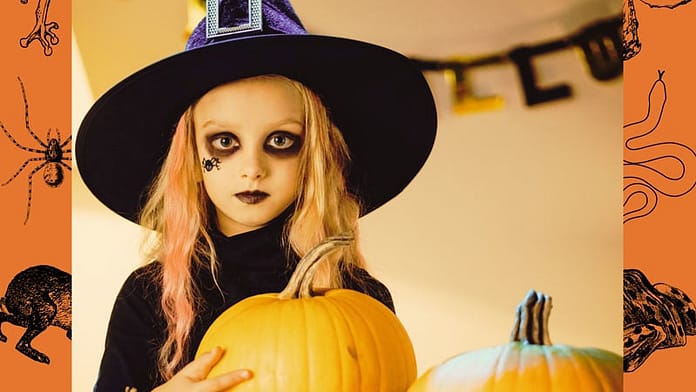What are the origins and spiritual meaning of Halloween?The history of this spookiest holiday dates back to the Celtic tribes of the British. Halloween has a mix of Christian, Roman and pagan origins. What not many people know is that Christianity has inadvertently led to Halloween being associated with all things spooky. The trick-or-treating element, combined with begging for sweets, has its origins in Guy Fawkes Night, which takes place in the UK on November 5th.
Pagan origins From Halloween
So let’s explore the origins of this darkest of holidays. We already covered the fall equinox (Mabon) in my Libra season post. It is one of the most important pagan holidays of the year. The astrological point of quarterly festivals is always at 15° of the sign occupied by the Sun. So Samhain would be 15° Scorpio. (Naturally!)
Halloween then begins with Samhain, which is celebrated on November 1st. The association with death arises from the fact that in the Northern Hemisphere at this time of year the night hours begin to outnumber the daylight hours.
The sun is getting lower in the sky every day. The nights are falling. There will be a harvest festival that will accompany us through the long, cold winter months. But if the harvest was bad, you could starve. So this time of year was very much a matter of life and death.
The Celts and Samhain
The Celts believed that in this transition from light to darkness, time and space become permeable. So much so that the spirits of the dead and the past could merge with our reality. At the same time, we could travel through time ourselves. You travel to other dimensions, could be intentional or, if you have a very tenuous grip on reality, you could accidentally wander into the other world.


The origin of all Halloween celebrations lies in the stories of people trapped in the underworld on Samhain evening. And the appearance of the dead among the living. Of course, this very much reflects what is happening to nature.
The plants shrink and die, leaves dry up and fall to the grown plants. The fall colors are intense reds, oranges, rust, gold and rich yellows.
The glow of the campfire reflects these warm colors. Of course, the signature orange pumpkins harvested in late October eventually became the hallmark of this holiday in modern times.
Roman Lemuria and exorcism of spirits
The connection between Christianity and paganism is fascinating. Just as Greek myths evolved into Roman myths, the same applies to our Halloween story. In Roman times there was a spooky festival called Lemuria. (Interesting name as there are other associations with this word. I don’t have time to go into detail here, but look it up.) Lemuria. )
Lemuria was celebrated on May 9th, 11th and 13th. The Romans performed rituals to exorcise spirits and malevolent demons from their homes. To appease them, people offered beans as a sacrifice. It was customary for the head of the family to go barefoot at night and throw black beans over his shoulder.
The rest of the family banged pots together and shouted, “Spirits of my fathers and ancestors, disappear!” As a result of this expulsion of evil spirits, the month of May was considered very unlucky for marriage. “Mense Maio Malae Nebunt” (translated means “bad girls get married in May!)” The feast day was later changed to “All Saints Day” around 610 to honor the holiest of all Christians
Halloween, All Saints Day and Christianity
The holiday was such a success that church leaders decided to postpone the celebration until November 1st. The motivation behind the postponement was to ease the heat of the very popular Samhain festival, which fell on the same day.
We can see very close connections between Samhain and All Saints’ Day in the Mexican Day of the Dead, which is celebrated on the same days as Halloween and dates back to the Spanish colonization of South America.
“The multi-day holiday brings family and friends together to pray for and remember deceased friends and family members. It is generally portrayed as a day of celebration rather than a day of mourning. The celebration has always been family-oriented, and the idea of having a citywide parade of people in Halloween-like costumes only came about in 2016, a year after Metro-Goldwyn-Mayer came up with one day of the Dead Parade in Mexico City for the James Bond film spook. “~Wikipedia
What happened at Samhain?
After the last summer harvest, villages would band together with their Druid priests to light a huge fire using a wheel to fan the flames. The wheel symbolized the rotation of the year and the sun’s journey through the sky. Cattle were sacrificed and the celebrants lit their home hearth with a flame from the fire at home.
Some documents speak of copious alcohol consumption, lavish feasting and revelry. You can see why people would look forward to this huge party after the hard work of harvesting. This enjoyment is reflected in modern Halloween, where children stuff their faces with candy.
Scary monsters!
The monstrous side of Halloween also has its origins in Samhain. The Celts believed that the barriers between empires were permeable at this time. The Celts made offerings to the fairies and disguised themselves as animals to prevent them from being abducted by these interdimensional beings. In the Middle Ages, fire festivals became a tradition and were intended to protect the family home from cheeky fairies and witches. We think of fairies as cute, kind creatures, but the Celts apparently thought otherwise!
Jack O’Lantern Myth & Pumpkins
The pumpkin tradition began with the humble turnip. Children carved faces out of turnips, hung them on the end of a string and filled them with coal. The lantern was of Irish origin and was called “Jack O Lantern,” named after a man named “Stingy Jack.” According to legend, Jack invited the devil for a drink but didn’t want to pay.
Jack convinced the devil to turn himself into a coin shape to pay for their drinks. However, Stingy Jack wanted to keep the money, so he put the demonic coin in his pocket next to a silver crucifix. The cross prevented the devil from returning to his physical form. Finally, Jack freed the devil with the promise that he would not bother him for a year and would not lay claim to his soul after his death.
Dealings with the devil
Years passed as the miserly Jack tricked the devil into stealing for him and then keeping him at bay with a cross. But when Jack died, God was not impressed by the ruse and banished Jack from heaven. Of course, Jack was also banished from Hell, leaving him to wander the earth with only a burning coal lantern as light.
England and Scotland made their own versions of the spooky face carvings to ward off “Stingy Jack” and other lost demons. The English used beets, but when they came to the United States, they discovered that the giant American pumpkins were a more than ideal substitute for their small British root vegetables.
Origins of the name Halloween
The transition from Samhain to what we know as Halloween occurs through the merging of pagan traditions with Christian ones. The pagan Samhain fell on the night before the Christian All Saints Day. In England, this day was known as “All Hallows Day,” so of course the night before was called “All Hallows Evening.” This phrase was shortened to “All Hallows Even,” which in turn was shortened to “Halloween!”
The church took another step to solidify its claim to Halloween by establishing a new holiday on November 2, All Souls’ Day, to honor the ordinary dead rather than the saints. So now the scary ones come into play, because the common folk tend to be more tainted than the heavenly saints! Average dead people tend to sin more.
We then return to the Celtic idea of the thinning of the veil and the dark gate between life and death. Therefore, priests urged Christians to pray for the souls trapped between heaven and hell in this sub-region called Purgatory. If enough people would pray for these poor, unfortunate, stuck souls, they would be lifted up to heaven and saved.
“Treat or Treat” and soul cake
The origin of “Trick or Treat” has its roots in Christianity. In the Middle Ages, children begged for “soul cakes”. In return, the children promised to pray for the souls trapped in Purgatory. Over time, the dark side of the tradition became more and more prominent, especially when there was a bad harvest.
So you can imagine desperate families sending their children to demand food for the whole family from wealthier households. Desperate times call for desperate measures, and you can understand why the demands are becoming increasingly threatening and even violent.
Often drunken adult beggars accompanied the children and it was quite loud. The gangs began wearing masks to protect their identities, throwing stones at houses or releasing livestock when they didn’t get enough treats.
Another custom of the time involved roving minstrels and gypsies performing plays and songs on people’s doorsteps (also in masks and costumes) in exchange for food or money. Over time, these traditions disappeared as people grew tired of the chaotic pranks and destruction.
Halloween can be cathartic as we get to explore our dark side, and it’s also exciting. Halloween inspires the naughty child in all of us. At the same time, you can see that Halloween has brought to the surface all of humanity’s fears and dark sides over the centuries. On Halloween we learn to live with our evil twin, tame him and accept the ghosts of our past. It is a transmutation exercise in which we face our demons and make fun of them. Laughter kills parasites!

